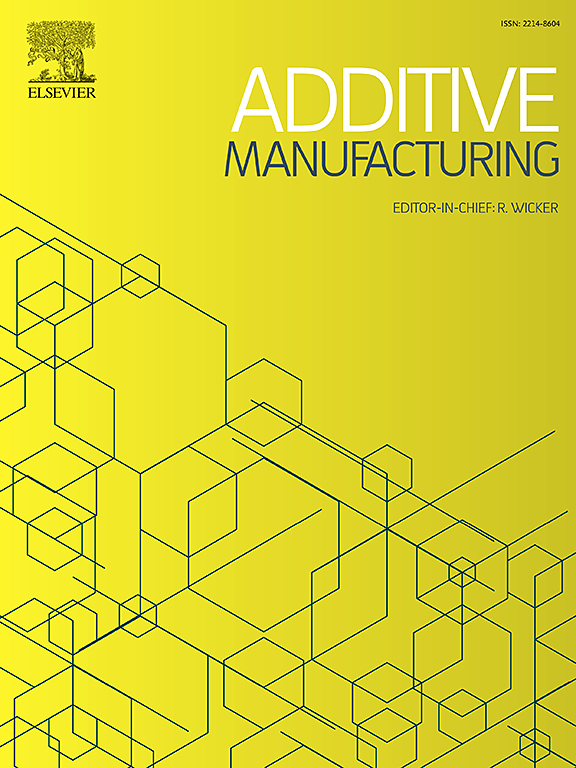Vacuum additive manufacturing of polyether ether ketone: Prediction of mechanical properties and forming mechanism
IF 10.3
1区 工程技术
Q1 ENGINEERING, MANUFACTURING
引用次数: 0
Abstract
Polyether ether ketone (PEEK) 3D printing technology has enormous potential uses in space exploration and engineering because of the exceptional qualities of material and ability to withstand the harsh conditions of the space environment. Considering the significant influence of the vacuum environment on the thermal history and resin rheology of the 3D printing process, this study establishes a predictive model using response surface methodology (RSM) to correlate axial tensile strength with critical process parameters under 10 Pa vacuum environment (VAC) and standard atmospheric pressure (ATM). Moreover, the relationship between tensile strength and process parameters across different environmental pressures is analyzed using analysis of variance (ANOVA) and univariate analysis. To further understand the intricate behaviors of PEEK during 3D printing, cooling and non-isothermal crystallization models, the neck growth model, and the pore growth model were developed for both VAC and ATM conditions. These models were validated through crystallinity assessments, microstructural cross-section analysis, and monofilament extrusion tests. Experimental results reveal that the theoretical model provides an accurate depiction of heat and mass transfer processes in VAC and ATM conditions. The results calculated using the theoretical model systematically elucidate the influence mechanisms of the vacuum environment on heat and mass transfer, resin rheological behavior, and defect formation. The study explains the different effects of process parameters on the tensile properties under VAC and ATM pressure conditions and proposes a defect formation mechanism for vacuum-printed samples, attributed to the expansion of initial pores within the filament driven by the pressure difference between the internal and external environments.
聚醚醚酮的真空增材制造:力学性能预测及形成机理
聚醚醚酮(PEEK) 3D打印技术在空间探索和工程中具有巨大的潜在用途,因为材料的卓越品质和承受空间环境恶劣条件的能力。考虑到真空环境对3D打印过程的热历史和树脂流变学的重大影响,本研究建立了一个预测模型,利用响应面法(RSM)在10 Pa真空环境(VAC)和标准大气压(ATM)下将轴向抗拉强度与关键工艺参数关联起来。此外,利用方差分析(ANOVA)和单变量分析分析了不同环境压力下拉伸强度与工艺参数之间的关系。为了进一步了解PEEK在3D打印过程中的复杂行为,在VAC和ATM条件下建立了冷却和非等温结晶模型、颈部生长模型和孔隙生长模型。这些模型通过结晶度评估、微观结构截面分析和单丝挤压试验进行了验证。实验结果表明,理论模型能较准确地描述真空和ATM条件下的传热传质过程。利用理论模型计算的结果系统地阐明了真空环境对热传质、树脂流变行为和缺陷形成的影响机制。本研究解释了在VAC和ATM压力条件下工艺参数对拉伸性能的不同影响,并提出了真空打印样品的缺陷形成机制,这是由于内外环境的压力差驱动长丝内部初始孔隙的膨胀。
本文章由计算机程序翻译,如有差异,请以英文原文为准。
求助全文
约1分钟内获得全文
求助全文
来源期刊

Additive manufacturing
Materials Science-General Materials Science
CiteScore
19.80
自引率
12.70%
发文量
648
审稿时长
35 days
期刊介绍:
Additive Manufacturing stands as a peer-reviewed journal dedicated to delivering high-quality research papers and reviews in the field of additive manufacturing, serving both academia and industry leaders. The journal's objective is to recognize the innovative essence of additive manufacturing and its diverse applications, providing a comprehensive overview of current developments and future prospects.
The transformative potential of additive manufacturing technologies in product design and manufacturing is poised to disrupt traditional approaches. In response to this paradigm shift, a distinctive and comprehensive publication outlet was essential. Additive Manufacturing fulfills this need, offering a platform for engineers, materials scientists, and practitioners across academia and various industries to document and share innovations in these evolving technologies.
 求助内容:
求助内容: 应助结果提醒方式:
应助结果提醒方式:


